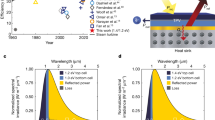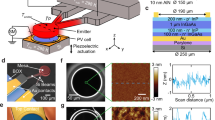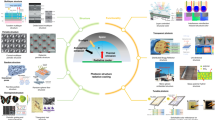Abstract
In solar cells, the mismatch between the Sun's emission spectrum and the cells’ absorption profile limits the efficiency of such devices1, while in incandescent light bulbs, most of the energy is lost as heat2. One way to avoid the waste of a large fraction of the radiation emitted from hot objects is to tailor the thermal emission spectrum according to the desired application. This strategy has been successfully applied to photonic-crystal emitters at moderate temperatures3,4,5,6,7,8, but is exceedingly difficult for hot emitters (>1,000 K)9,10,11,12,13,14. Here, we show that a plain incandescent tungsten filament (3,000 K) surrounded by a cold-side nanophotonic interference system optimized to reflect infrared light and transmit visible light for a wide range of angles could become a light source that reaches luminous efficiencies (∼40%) surpassing existing lighting technologies, and nearing a limit for lighting applications. We experimentally demonstrate a proof-of-principle incandescent emitter with efficiency approaching that of commercial fluorescent or light-emitting diode bulbs, but with exceptional reproduction of colours and scalable power. The ability to tailor the emission spectrum of high-temperature sources may find applications in thermophotovoltaic energy conversion15,16,17,18 and lighting.
This is a preview of subscription content, access via your institution
Access options
Subscribe to this journal
Receive 12 print issues and online access
$259.00 per year
only $21.58 per issue
Buy this article
- Purchase on Springer Link
- Instant access to full article PDF
Prices may be subject to local taxes which are calculated during checkout




Similar content being viewed by others
References
Shockley, W. & Queisser, H. J. Detailed balance limit of efficiency of p–n junction solar cells. J. Appl. Phys. 32, 510–519 (1961).
US Department of Energy. Lighting Basics (accessed May 2015); http://energy.gov/eere/energybasics/articles/lighting-basics
Greffet, J.-J. et al. Coherent emission of light by thermal sources. Nature 416, 61–64 (2002).
De Zoysa, M. et al. Conversion of broadband to narrowband thermal emission through energy recycling. Nature Photon. 6, 535–539 (2012).
Inoue, T., De Zoysa, M., Asano, T. & Noda, S. Realization of dynamic thermal emission control. Nature Mater. 13, 928–931 (2014).
Raman, A. P., Anoma, M. A., Zhu, L., Rephaeli, E. & Fan, S. Passive radiative cooling below ambient air temperature under direct sunlight. Nature 515, 540–544 (2014).
Liu, X. et al. Taming the blackbody with infrared metamaterials as selective thermal emitters. Phys. Rev. Lett. 107, 045901 (2011).
Han, S. E., Stein, A. & Norris, D. J. Tailoring self-assembled metallic photonic crystals for modified thermal emission. Phys. Rev. Lett. 99, 053906 (2007).
Schlemmer, C., Aschaber, J., Boerner, V. & Luther, J. Thermal stability of micro-structured selective tungsten emitters. AIP Conf. Proc. 653, 164–173 (2003).
Sai, H., Kanamori, Y. & Yugami, H. High-temperature resistive surface grating for spectral control of thermal radiation. Appl. Phys. Lett. 82, 1685–1687 (2003).
Nagpal, P. et al. Fabrication of carbon/refractory metal nanocomposites as thermally stable metallic photonic crystals. J. Mater. Chem. 21, 10836–10843 (2011).
Arpin, K. A. et al. Three-dimensional self-assembled photonic crystals with high temperature stability for thermal emission modification. Nature Commun. 4, 2630 (2013).
Arpin, K. A., Losego, M. D. & Braun, P. V. Electrodeposited 3D tungsten photonic crystals with enhanced thermal stability. Chem. Mater. 23, 4783–4788 (2011).
Rinnerbauer, V. et al. High-temperature stability and selective thermal emission of polycrystalline tantalum photonic crystals. Opt. Express 21, 011482 (2013).
Lin, S. Y., Moreno, J. & Fleming, J. G. Three-dimensional photonic-crystal emitter for thermal photovoltaic power generation. Appl. Phys. Lett. 83, 380 (2003).
Chubb, D. L. Fundamentals of Thermophotovoltaic Energy Conversion (Elsevier, 2007).
Lenert, A. et al. A nanophotonic solar thermophotovoltaic device. Nature Nanotech. 9, 126–130 (2014).
Chan, W. R. et al. Toward high-energy-density, high-efficiency, and moderate-temperature chip-scale thermophotovoltaic. Proc. Natl Acad. Sci. USA 110, 5309–5314 (2013).
Sharpe, L. T., Stockman, A., Jagla, W. & Jägle, H. A luminous efficiency function, V*(λ), for daylight adaptation. J. Vision 5, 948–968 (2005).
Kostlin, H. & Almer, F. H. R. Incandescent lamp with infrared filter. US patent 4,017,758 (1977).
Goldstein, I. S., Fontana, R. P., Thorington, L. & Howson, R. P. The design, construction and performance of an incandescent light source with a transparent heat mirror. Lighting Res. Technol. 18, 93–97 (1986).
Bergman, R. S. Halogen–IR lamp development: a system approach. J. Illum. Eng. Soc. 20, 10–16 (1991).
Hecht, E. Optics 4th edn (Addison-Wesley, 2002).
Baumeister, P. Simulation of a rugate filter via a stepped-index dielectric multilayer. Appl. Opt. 25, 2644–2645 (1986).
Next Generation Luminaires (NGL) Solid-State Lighting Design Competition (2014), sponsored by the US Department of Energy; http://www.ngldc.org
Philips creates the world's most energy-efficient warm white LED lamp Press release (April 2013); http://www.newscenter.philips.com/main/standard/news/press/2013/20130411-philips-creates-the-world-s-most-energy-efficient-warm-white-led-lamp.wpd
Wyszecki, G. & Stiles, W. S. Color Science: Concepts and Methods, Quantitative Data and Formulae 2nd edn (Wiley, 1982).
US Department of Energy, Office of Energy Efficiency and Renewable Energy, CALIPER Snapshot Reports (2014); http://energy.gov/eere/ssl/caliper-snapshot-reports
Lin, S. Y. et al. A three-dimensional photonic crystal operating at infrared wavelengths. Nature 394, 251–253 (1998).
Fleming, J. G., Lin, S. Y., El-Kady, I., Biswas, R. & Ho, K. M. All-metallic three-dimensional photonic crystals with a large infrared bandgap. Nature 417, 52–55 (2002).
Touloukian, Y. S. & DeWitt, D. P. Thermophysical Properties of Matter. Thermal Radiative Properties: Metallic Elements and Alloys Vol. 7 (IFI/Plenum, 1970).
Demiryont, H., Sites, J. R. & Geib, K. Effects of oxygen content on the optical properties of tantalum oxide films deposited by ion-beam sputtering. Appl. Opt. 24, 490 (1985).
Harry, G., Bodiya, T. P. & DeSalvo, R. Optical Coatings and Thermal Noise in Precision Measurement (Cambridge Univ. Press, 2012).
Desai, P. D., Chu, T. K., James, H. M. & Ho, C. Y. Electrical resistivity of selected elements. J. Phys. Chem. Ref. Data 13, 1069–1096 (1984).
Powell, R. W., Ho, C. Y. & Liley, P. E. Thermal Conductivity of Selected Materials (National Standard Reference Data Series 8, National Bureau of Standards, 1966).
White, G. K. & Collocott, S. J. Heat capacity of reference materials: Cu and W. J. Phys. Chem. Ref. Data 13, 1251–1257 (1984).
Larouche, S. & Martinu, L. OpenFilters: open-source software for the design, optimization, and synthesis of optical filters. Appl. Opt. 47, C219–C230 (2008).
Tikhonravov, A. V., Trubetskov, M. K. & DeBell, G. W. Application of the needle optimization technique to the design of optical coatings. Appl. Opt. 35, 5493–5508 (1996).
Johnson, S. G. The NLopt nonlinear-optimization package; http://ab-initio.mit.edu/nlopt
Carniglia, C. K. in Laser-Induced Damage in Optical Materials: 1987 (eds Bennet, H. E. et al.) 272–277 (Special Publication 756, US National Institute of Standards and Technology, 1988).
Acknowledgements
The authors thank P. Rebusco for critical reading and editing of the manuscript, and J.J. Senkevich, W. Chan, S. Kooi, I. Wang, A. Cukierman, M. Harradon, A. Musabeyoglu, S. Johnson and Y. Xiang Yeng for valuable input. This work was partially supported by the Army Research Office through the ISN (contract no.W911NF-13-D0001). The fabrication part of the effort was supported by S3TEC, an Energy Frontier Research Center funded by the US Department of Energy (DOE), Office of Science, Basic Energy Sciences (BES) (award no. DE-SC0001299/DE-FG02-09ER46577).
Author information
Authors and Affiliations
Contributions
All authors discussed the results and made critical contributions to the work.
Corresponding author
Ethics declarations
Competing interests
The authors declare no competing financial interests.
Supplementary information
Supplementary information
Supplementary information (PDF 966 kb)
Rights and permissions
About this article
Cite this article
Ilic, O., Bermel, P., Chen, G. et al. Tailoring high-temperature radiation and the resurrection of the incandescent source. Nature Nanotech 11, 320–324 (2016). https://doi.org/10.1038/nnano.2015.309
Received:
Accepted:
Published:
Issue Date:
DOI: https://doi.org/10.1038/nnano.2015.309
This article is cited by
-
Incandescent temporal metamaterials
Nature Communications (2023)
-
Thermal photonics with broken symmetries
eLight (2022)
-
Optical emissivity dataset of multi-material heterogeneous designs generated with automated figure extraction
Scientific Data (2022)
-
Super-Planckian emission cannot really be ‘thermal’
Nature Photonics (2022)
-
Radiative cooling technologies: a platform for passive heat dissipation
Journal of the Korean Physical Society (2022)



